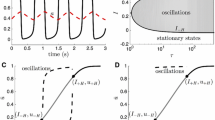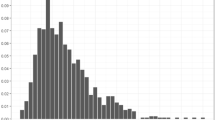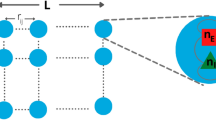Abstract
For the Ornstein-Uhlenbeck neuronal model a quantitative method is proposed for the estimation of the two parameters characterizing the unkown input process, namely the neuron's mean input per unit time μ and the infinitesimal standard deviation per unit time σ. This method is based on the experimentally observed first- and second-order moments of interspike intervals. The dependence of the estimates \(\hat \mu\) and \(\hat \sigma\) on the moments of the observed interspike intervals and on the neuronal parameters is clarified, and a comparison is made between the estimates based on the classical Wiener model and those yielded by the Ornstein-Uhlenbeck model. Comprehensive tables are included in which the displayed values of \(\hat \mu\) and \(\hat \sigma\) have been calculated in terms of physiologically realistic pairs of first- and second-order moments. Our method is finally applied to interspike interval data recorded from neurons in the mesencephalic reticular formation of the cat during hypothetical sleep, slow-wave sleep stage, and wake stage.
Similar content being viewed by others
Abbreviations
- X(t) :
-
The Ornstein-Uhlenbeck (OU) process
- T s :
-
The first-passage time (FPT) to a constant boundary S for the OU process X(t) starting at x 0
- μ :
-
The constant drift of the OU process or the mean input per unit time to a neuron for the OU model
- \(\hat \mu\), \(\hat \mu\) 0 :
-
The estimate of μ
- \(\hat \mu\) w :
-
The estimated constant drift of the Wiener process or the mean input per unit time to a neuron for the Wiener model
- σ :
-
The infinitesimal standard deviation of the OU process or the input standard deviation per unit time to a neuron for the OU model
- \(\hat \sigma\), \(\hat \sigma\) 0 :
-
The estimate of σ
- \(\hat \sigma\) w :
-
The estimated infinitesimal standard deviation of the Wiener process or input standard deviation per unit time for the Wiener model
- x 0 :
-
The initial value of the OU process or the difference of the initial membrane potential from the resting potential
- S :
-
The difference between the resting potential and the threshold potential
- τ :
-
The membrane time constant of a neuron
- x 0, S, and \(\bar \tau\) :
-
A preassigned value for x 0, S, and τ, respectively
- X′(t′):
-
The ‘normalized’ OU process
- ξ :
-
The initial value of the ‘normalized’ OU process
- η :
-
The threshold value in the ‘normalized’ OU process
- \(\hat \xi\) and \(\hat \eta\) :
-
The estimate of ξ and η, respectively
- g(t ‖ S, x 0):
-
The FPT probability density function (pdf) of the OU process X(t)
- g′(t′ ¦η, ξ):
-
The FPT pdf of the normalized OU process X′(t′)
- m 1 :
-
The first moment about the origin of the FPT for the OU process X(t) or the sample mean of the interspke intervals (ISIs)
- m 2 :
-
The second moment about the origin of the FPT for the OU process X(t) or the second sample moment of the ISIs
- M 1 :
-
The first moment about the origin of the FPT for the normalized OU process or the sample mean of the ISIs normalized by \(\bar \tau\) (M 1 ≡ m 1/\(\bar \tau\))
- CV:
-
The coefficient of variation of the FPT of the OU process X(t) and of the normalized OU process X′(t′) or the sample coefficient of variation of the ISIs and of the ISIs normalized by τ (CV ≡ standard deviation/mean)
- PS, SWS, and BIR:
-
paradoxical sleep, slow-wave sleep, and the attentive state of bird watching
References
Anastasio TJ, Correia MJ, Perachio AA (1985) Spontaneous and driven responses of semicircular canal primary afferents in the unanesthetized pigeon. J Neurophysiol 54:335–347
Buonocore A, Nobile AG, Ricciardi LM (1987) A new integral equation for the evaluation of first-passage-time probability densities. Adv Appl Prob 19:784–800
Capocelli RM, Ricciardi LM (1973) A continuous Markovian model for neuronal activity. J Theor Biol 40:369–387
Correia MJ, Landolt JP (1977) A point process analysis of the spontaneous activity of anterior semicircular canal unit in the anesthetized pigeon. Biol Cybern 27:199–213
Gerstein GL, Mandelbrot B (1964) Random walk models for the spike activity of a single neuron. Biophys J 4:41–68
Giorno V, Lansky P, Nobile AG, Ricciardi LM (1988) Diffusion approximation and first-passage-time problem for a model neuron. III. A birth-and-death process approach. Biol Cybern 58:387–404
Giorno V, Nobile AG, Ricciardi LM (1990) On the asymptotic behaviour of first-passage-time densities for one-dimensional diffusion processes and varying boundaries. Adv Appl Prob 22:883–914
Habib MK (1992) Optimal estimation for semimartingale neuronal models. J Stat Plan Inference 33:143–156
Hanson FB, Tuckwell HC (1983) Diffusion approximation for neuronal activity including synaptic reversal potential. J Theor Neurobiol 2:127–153
Kandel ER, Schwartz JH (1985) Principles of neural science, 2nd edn. Elsevier, New York
Keilson J, Ross HF (1975) Passage time distributions for gaussian Markov (Ornstein Uhlenbeck) statistical processes. Selected tables in mathematical statistics, Vol III. American Mathematical Society, pp 233–327
Lánský P (1983) Inference for the diffusion models of neuronal activity. Math Biosci 67:247–260
Lánský P, Lánská V (1987) Diffusion approximation of the neuronal model with synaptic reversal potentials. Biol Cybern 56:19–26
Lánský P, Radil T (1987) Statistical inference on spontaneous neuronal discharge patterns. Biol Cybern 55:299–311
Lánský P, Giorno V, Nobile AG, Ricciardi LM (1988) A diffusion neuronal model and its parameters. In: Ricciardi LM (eds) Biomathematics and related computational problems. Kluwer, Dordrecht, pp 27–37
Lánský P, Smith CE, Ricciardi LM (1990) One-dimensional stochastic diffusion models of neuronal activity and related first passage time problems. Trends Biol Cybern 1:153–162
Levine MW (1991) The distribution of the intervals between neural impulses in the maintained discharges of retinal ganglion cells. Biol Cybern 65:459–467
Musila M, Lánský P (1991) Generalized Stein's model for anatomically complex neurons. Biosystems 25:179–191
Nobile A, Ricciardi LM, Sacerdote L (1985) Exponential trends of Ornstein-Uhlenbeck first passage time densities. J Appl Prob 22:360–369
Ortega JM, Rheinboldt WC (1970) Iterative solution of nonlinear equations in several variables. Academic Press, New York
Ricciardi LM (1976) Diffusion approximation for a multi-input model neuron. Biol Cybern 24:237–240
Ricciardi LM (1977) Diffusion processes and related topics in biology. Lecture notes in Biomathmatics, Vol 14 Springer, Berlin Heidelberg New York
Ricciardi LM, Sato S (1988) First-passage-time density and moments of the Ornstein-Uhlenbeck process. J Appl Prob 25:43–57
Rospars JP, Lánský P (1993) Stochastic model neuron without resetting of dendritic potential: application to the olfactory system. Biol Cybern 69:283–294
Roy K, Smith DR (1969) Analysis of the exponential decay model of the neuron showing frequency threshold effects. Bull Math Biophys 31:341–357
Smith CE, Smith MV (1984) Moments of voltage trajectories for Stein's model with synaptic reversal potentials. J Theor Neurobiol 3:67–77
Tuckwell HC (1979) Synaptic transmission in a model for stochastic neuronal activity. J Theor Biol 77:65–81
Tuckwell HC (1982) Neuronal firing and input variability. J Theor Neurobiol 1:197–218
Tuckwell HC (1988) Introduction to theoretical neurobiology, Vol. 2. Nonlinear and stochastic theories. Cambridge University Press, New York
Tuckwell HC (1989) Stochastic processes in the neurosciences. CBMS 56, SIAM
Tuckwell HC, Richter W (1978) Neuronal interspike time distribution and the estimation of neurophysiological and neuroanatomical parameters. J Theor Biol 71:167–183
Wilbur WJ, Rinzel J (1983) A theoretical basis for large coefficient of ariation and bimodality in neuronal interspike interval distributions. J Theor Biol 105:345–368
Yamamoto M, Nakahama H, Shima K, Komada T, Mushiake H (1986) Markov-dependency and spectral analyses on spike counts in mesencephalic reticular neurons during sleep and attentive states. Brain Res 366:279–289
Author information
Authors and Affiliations
Rights and permissions
About this article
Cite this article
Inoue, J., Sato, S. & Ricciardi, L.M. On the parameter estimation for diffusion models of single neuron's activities. Biol. Cybern. 73, 209–221 (1995). https://doi.org/10.1007/BF00201423
Received:
Accepted:
Issue Date:
DOI: https://doi.org/10.1007/BF00201423




